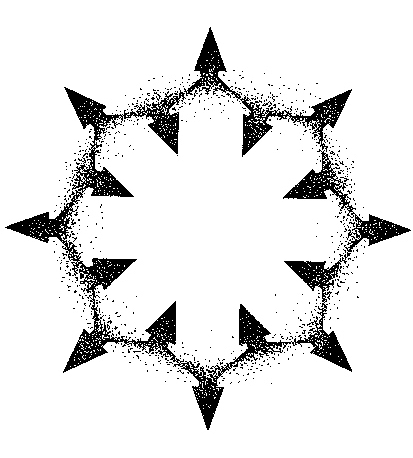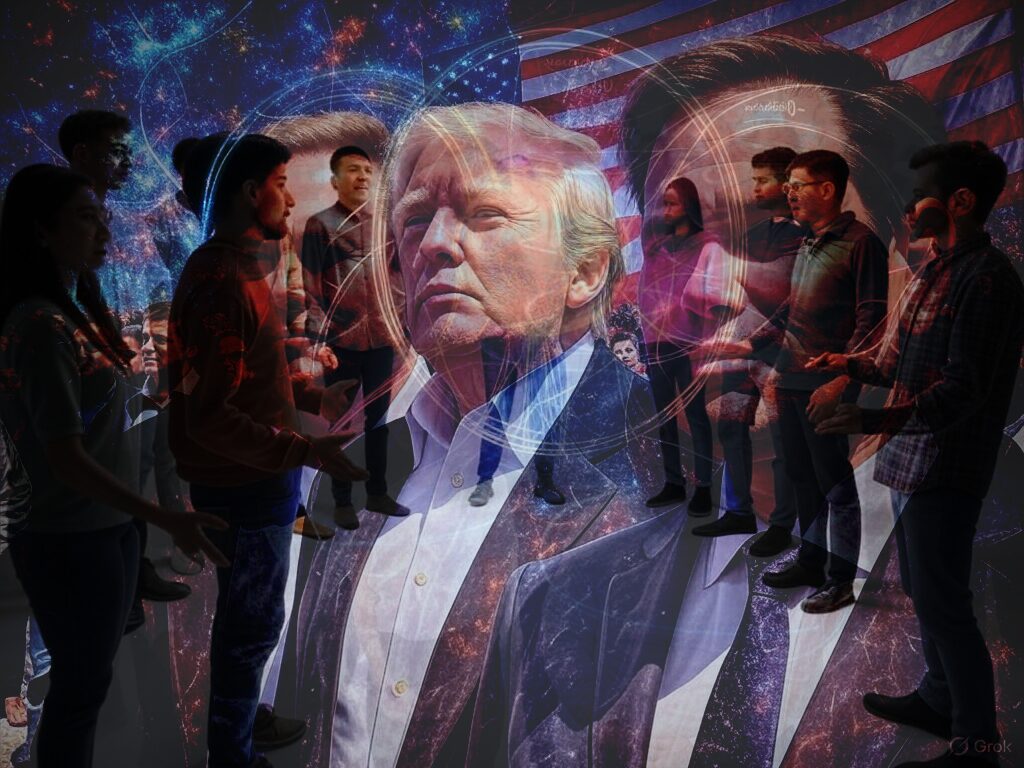The Trump/Musk strategy uses chaos—via rapid, disruptive moves and amplified feedback loops—to enact Project 2025’s radical vision
Let’s explore how the Trump/Musk team’s strategy leverages a chaotic approach to amplify feedback loops, driving disruptive change aligned with Project 2025’s vision, and assesshow this will affect folks, both in the U.S. and globally. I’ll draw on the Socio-Quantum Behavioral Synthesis (SQBS) framework where applicable, recent events as of March 30, 2025, and insights into Project 2025’s goals, while critically analyzing potential outcomes.
Conclusion
The Trump/Musk strategy uses chaos—via rapid, disruptive moves and amplified feedback loops—to enact Project 2025’s radical vision, dismantling governance norms and imposing a new order. SQBS illuminates how this thrives on non-linearity and perturbation, but the outcomes heavily disfavor the poor, working class, and marginalized groups. Real-world examples—like tariff threats, federal cuts, and deportation plans—show short-term disruption benefits elites (e.g., Musk’s firms) while long-term chaos erodes stability for most. By 2028, expect a polarized, unequal U.S. and a fragmented world, unless counter-forces (e.g., judicial blocks, EU-Canada resilience) shift the trajectory.
Trump/Musk Strategy: Chaos as a Catalyst
The Trump/Musk partnership exhibits a chaotic approach that aligns with SQBS’s emphasis on non-linear dynamics and feedback loops. Here’s how it manifests:
- Behavioral State Encoding and Chaotic Perturbations (
v_x, v_y, v_z + \epsilon):- Trump’s administration, with Musk’s influence via the Department of Government Efficiency (DOGE), operates with high “social influence speed” ((c))—think rapid executive orders and social media blitzes (e.g., Trump’s March 27, 2025, tariff threat). Their behavioral state vectors show low conformity (
v_x) with traditional governance norms (e.g., NATO, federal bureaucracy) and high innovation/conflict (v_y) via radical proposals like annexing Greenland or slashing federal jobs. - Chaotic perturbations (
\epsilon)—such as leaked Yemen strike plans (March 24, 2025) or Musk’s abrupt DOGE cuts—destabilize systems, creating uncertainty that amplifies their momentum.
- Trump’s administration, with Musk’s influence via the Department of Government Efficiency (DOGE), operates with high “social influence speed” ((c))—think rapid executive orders and social media blitzes (e.g., Trump’s March 27, 2025, tariff threat). Their behavioral state vectors show low conformity (
- Wavefunction Interference and Probability Amplification:
- SQBS’s
P_{\text{misalign}} = \sin^2(\theta/2) \cdot (1 + \beta |\epsilon|)reflects how chaos boosts resistance to established norms. Trump/Musk’s misalignment with allies (high\theta)—e.g., NATO spending disputes or Canada/EU trade threats—grows as chaotic actions (high|\epsilon|) like tariff escalations amplifyP_{\text{misalign}}, fracturing coalitions and pushing unilateral policies.
- SQBS’s
- Holographic Feedback Loops (
e^{\lambda |\epsilon|^2}):- Small perturbations explode into systemic shifts. Musk’s DOGE firing of 30,000 federal workers (January 20, 2025, per The Telegraph) and Trump’s abolition of the Department of Education (March 20, 2025) trigger exponential feedback—legal challenges, union backlash, and congressional resistance—yet also entrench their control by overwhelming opposition with rapid, chaotic moves.
- This mirrors Project 2025’s aim to “deconstruct the Administrative State” (Pillar Two), replacing bureaucrats with loyalists, as seen in appointees like Tom Homan (border czar) and Pete Hegseth (Defense Secretary).
- Strange Attractors and Paradigm Shifts:
- SQBS predicts shifts when chaos (
|\chi(t)|) exceeds thresholds (\kappa). Trump/Musk’s disruption—e.g., Musk’s budget cuts targeting Head Start (The New Republic, February 16, 2025)—aims to collapse old paradigms (liberal governance) and stabilize a new attractor: a lean, authoritarian state aligned with Project 2025’s 900-page Mandate for Leadership.
- SQBS predicts shifts when chaos (
Project 2025 Alignment:
- Immigration: Project 2025 calls for militarized borders and mass deportations (Heritage Foundation, 2024). Trump’s promise of the “biggest deportation operation in history” and Homan’s military aircraft plans (The Telegraph, March 22, 2025) escalate this, using chaos (e.g., Springfield, Ohio, pet-eating rumors) to justify extreme measures.
- Government Efficiency: Musk’s DOGE slashes spending (e.g., $1.5-2 trillion proposed cuts, The Telegraph), echoing Project 2025’s workforce reduction goals, though exceeding its scope with AI-driven automation (Washington Post, February 8, 2025).
- Social Policy: Attacks on DEI, LGBTQ+ rights, and abortion (e.g., mifepristone bans in Project 2025) align with Trump’s rhetoric and executive actions, amplified by chaotic narratives (e.g., Musk’s “great replacement” claims, The Guardian, March 19, 2025).
Chaotic Approach in Action:
- The blitzkrieg pace—executive orders, firings, tariff threats—overloads systems, creating feedback loops where opposition struggles to respond (e.g., federal judge’s temporary block on DOGE cuts, reinstated 25,000 workers, The Telegraph). This chaos, per SQBS’s
e^{\lambda |\epsilon|^2}, drives disruptive change by shattering norms and installing a new order.
Outcomes for the Poor, Working Class, and Marginalized Groups
Now, let’s evaluate the fallout using SQBS’s lens and real-world evidence, focusing on economic, security, and wellbeing impacts.
1. Poor and Working Class (U.S.)
- Economic Impact:
- Trump/Musk Favorability: Musk’s DOGE cuts (e.g., Head Start, Consumer Financial Protection Board) target programs aiding low-income families (The New Republic). Tariffs (25% on EU/Canada) inflate costs—e.g., a 2025 U.S. consumer price hike projection of 5-7% (NYT, January 28, 2025)—hitting working-class budgets hardest.
- SQBS Insight: Low
A_s(attractor strength) for economic stability asP_{\text{misalign}}rises with policy chaos. Short-term job gains in defense (e.g., rally post-tariffs) erode as global trade retaliates, risking recession by 2027. - Example: Trump’s tax cuts (Project 2025-aligned) favor corporations, not workers, echoing his first term’s $1.5 trillion giveaway (Center for American Progress, 2024).
- Wellbeing:
- Prediction: Stagnant wages and rising costs (e.g., healthcare cuts in Project 2025) lower living standards. PRRI’s March 13, 2025, data shows white working-class support for Trump hinges on cultural anxiety, not economic relief, suggesting disillusionment by 2026.
- Example: Musk’s anti-union stance (praising Tesla’s firing of strikers, American Progress Action, October 31, 2024) undermines labor protections, weakening bargaining power.
2. Marginalized Groups (Immigrants, LGBTQ2+, People of Color)
- Immigrants:
- Impact: Mass deportations (11 million targeted, Project 2025) disrupt communities—e.g., Haitian migrants in Charleroi, PA, face raids (NYT, September 27, 2024). Chaos amplifies fear, with
P_{\text{align}}to U.S. norms dropping as|\epsilon|(deportation threats) spikes. - Global Ripple: Sanctioned countries refusing deportees (Project 2025) face U.S. retaliation, destabilizing poor nations’ economies (e.g., Yemen’s Houthi conflict escalates, AP, March 24, 2025).
- Impact: Mass deportations (11 million targeted, Project 2025) disrupt communities—e.g., Haitian migrants in Charleroi, PA, face raids (NYT, September 27, 2024). Chaos amplifies fear, with
- LGBTQ2+:
- Impact: Project 2025’s rollback of protections (e.g., school DEI bans) and Trump’s rhetoric (e.g., “vermin” opponents) signal exclusion. Chaos (
\chi(t)) from policy shifts erodes rights, with no economic offset. - Example: Education Department cuts (March 20, 2025) nix Title IX expansions, per The Guardian’s Project 2025 analysis.
- Impact: Project 2025’s rollback of protections (e.g., school DEI bans) and Trump’s rhetoric (e.g., “vermin” opponents) signal exclusion. Chaos (
- People of Color:
- Impact: Policing crackdowns (Project 2025’s end to consent decrees, The Independent, October 24, 2024) and economic exclusion (e.g., Head Start cuts) disproportionately harm Black and Latino communities. SQBS’s feedback loops amplify instability as
P_{\text{misalign}}grows. - Example: Trump’s false Aurora, CO, gang claims (NYT, September 15, 2024) fuel racial scapegoating, risking violence.
- Impact: Policing crackdowns (Project 2025’s end to consent decrees, The Independent, October 24, 2024) and economic exclusion (e.g., Head Start cuts) disproportionately harm Black and Latino communities. SQBS’s feedback loops amplify instability as
3. Working-Class White People
- U.S.:
- Impact: Cultural wins (e.g., immigration crackdowns) appeal to PRRI’s “Great Replacement” backers (March 13, 2025), but economic promises falter. Tariffs and automation (Musk’s AI push, Washington Post) cut manufacturing jobs, lowering
A_sfor stability. - Example: Trump’s first-term tax cuts didn’t boost wages (American Progress), and 2025’s chaos repeats this pattern.
- Impact: Cultural wins (e.g., immigration crackdowns) appeal to PRRI’s “Great Replacement” backers (March 13, 2025), but economic promises falter. Tariffs and automation (Musk’s AI push, Washington Post) cut manufacturing jobs, lowering
- Global:
- Impact: U.S.-centric policies (e.g., NATO withdrawal) disrupt allied working classes (e.g., EU defense jobs), with chaos exporting economic strain.
4. Global Poor and Marginalized
- Economic/Security:
- Prediction: Trade wars and climate policy rollbacks (Project 2025’s USAID climate cuts) hit developing nations hardest—e.g., Greenland’s resource exploitation (March 28, 2025, Vance visit) ignores local needs. SQBS’s
|\chi(t)|exceeding\kappaforecasts bifurcations like famine or conflict (e.g., Yemen). - Example: EU-Canada bloc (CBC, March 20, 2025) may exclude poor nations, widening gaps.
- Prediction: Trade wars and climate policy rollbacks (Project 2025’s USAID climate cuts) hit developing nations hardest—e.g., Greenland’s resource exploitation (March 28, 2025, Vance visit) ignores local needs. SQBS’s
Favorability Assessment
- Poor/Working Class: Unfavorable. Short-term populist gains (e.g., deportation cheers) fade as economic chaos (tariffs, cuts) raises costs and cuts safety nets. SQBS’s
e^{\lambda |\epsilon|^2}predicts exponential hardship by 2027. - Immigrants: Highly unfavorable. Deportations and visa cuts (Project 2025) devastate lives, with global backlash amplifying instability.
- LGBTQ2+/People of Color: Unfavorable. Policy rollbacks and scapegoating (e.g., Musk’s fraud claims, The Guardian) erode rights and safety, with no economic upside.
- Working-Class White People: Mixed but leaning unfavorable. Cultural alignment satisfies some, but job losses and price hikes (e.g., 5-7% inflation) outweigh benefits by 2026.
- Global Impact: Unfavorable. Chaos exports economic and security crises, disproportionately harming the poor and marginalized in allied and adversarial nations alike.


Leave a Reply